|
1.
CENTRAL/ WEST AFRICA
Logs and lumber face downward pressure on prices
There were no price changes through second half of October. Markets were stable overall but there were few
variations in offers for certain species that might be used to undercut the general price level. The mini-boom in
sapele prices seemed to have petered out and while most mills were offering at standard prices, there were reports
of some offers below these levels as buyers looked for cheaper alternatives. The downward pressure on lumber
prices might reflect back on log prices in due time. It was not clear whether sapele prices had reached a plateau.
There were also news of occasional offers of sipo logs and lumber at slightly below normal price levels. Germany
was reported to be overstocked with bubinga and ovangkol and buyers were out of the market for the time being.
Bubinga was one of the popular species that had seen some very substantial prices hikes in recent months due to
strong demand in Germany, France and China.
Meanwhile, the presence of China and India in West and Central Africa remained strong with well established
demand and regular shipments for all major species. Prices for these markets remained firm and stable.
Okoume lumber gains wider acceptance in Europe
German buyers were beginning to look at okoume lumber, possibly as a lower cost alternative for other red species.
Italy had been the first European country to have well accepted okoume lumber, largely to replace the more
pricey ayous (also known as obeche or wawa) for interior joinery use. Okoume lumber had become available in
much larger volumes as a result of the pioneering of few
producers and government policy in Gabon to move industry away from log exports to sawn lumber and
downstream processing. Okoume lumber had gained only a very small price increase of some $5-6 over recent
months, keeping this versatile timber competitive.
W. African market buoyed by steady demand in Asia
Heavy rains continued in Cameroon and in Gabon. The early onset of the rainy season was affecting log supply to
sawmills. The mills said the low log supply was offsetting any weakness in the
European market, though the approaching winter in Europe was a factor to be taken into
account. On the other hand, the stable demand from India and China and the very tight supply and high price regime
for Asian species would probably hold the West African market steady through into 2007.
Liberia secures investment in palm-oil development
Liberia has secured its first significant foreign investment with an agreement reached with Nardina Resources, a
London-listed company (shortly to be renamed Equatorial Bio-fuels), to develop the
country's palm-oil industry. The
industry would initially target the international market in palm-oil for foodstuffs and then expand into refining
palm-oil for biofuels. Nardina planned to invest between
$500-750 million over 20 years and, after capital costs had been recouped in 6-7 years, the
company is expected to pay Liberia $1 billion in tax. The palm-oil development is
expected to create at least 60,000 jobs.
Joseph Boakai, Liberia's Vice-president, said the deal could be swiftly followed by concessions in agriculture,
mining and fishing.
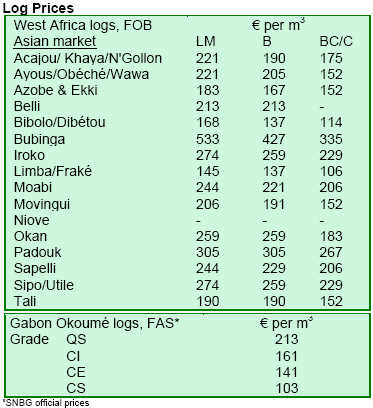
Beijing hosts summit on China-Africa cooperation
China will hold the ¡ˇăForum on China-Africa Cooperation¡ˇŔ (FOCAC) on November 3-5, which would probably be the
biggest summit to be held by China in modern history, according to Assistant Foreign Minister Zhai Jun. China
expects to strike a number of agreements on trade, investment, aid and debt forgiveness with some of the 48
African countries that will attend the summit. The main
objective of the summit is to establish a new type of partnership between China and African
countries in light of changing circumstances, Mr. Zhai said.
The gathering comes as many African leaders seek help to develop their strife-torn countries and with China looking
for new resources to meet its growing energy needs as well as new markets for its own emerging companies. It
will cap the growing ties between the two regions over recent years that have sparked some protests in the West.
Some countries have said that China was pressing African countries to borrow funds, after their debts had been
forgiven by the West. Increasingly, Western nations are seeking to tie aid with specific guarantees from
governments on fiscal and social policy, a policy China rejects.
Mr. Zhai argued that China did not condition aid and was not interested merely in tapping
Africa's oil and other
resources, but was eager to raise living standards in Africa and share lessons and
opportunities from its own development. According to him, China was pursuing
relations by seeking mutual benefits in an open and transparent manner.
Agreements in several key areas are expected to be announced by China's President Hu Jintao and signed
during the meeting. To encourage more imports from Africa, an expansion in the number of African goods that
would be subject to zero-percent tariff in China is likely to be included in the pacts. Currently, some 190 goods from
28 African countries, are exempted from tariffs. There will
also be pledges for more aid, including training in everything from medicine to agriculture, and investment in
Africa.
While Mr. Zhai did not disclose how much in loans African countries owe China, he said China would
announce another round of debt cancellation. He added that China's loans were a small proportion of the $284
billion in debt which Africa owed globally. China had already forgiven some $10 billion of debt in yuandenominated
loans, mostly for infrastructure projects.
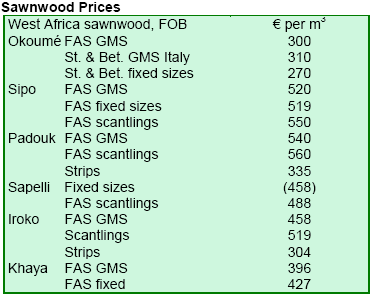
2. GHANA
Ghana timber exports lose ground in 2006
Earnings from timber exports fell to €112.6 million (288,895 m3) in Jan-Aug 2005, down 8% (down 7% in
volume) from the same period in 2005, according to the Timber Industry Development Division (TIDD) of the
Forestry Commission (FC).
Primary wood products (lumber, veneer, boules, poles, pegs, plywood and billet) and processed wood products
accounted for 88.7% and 11.3% of the exports, respectively. The FC attributed the export decline to
structural constraints, including deficient processing equipments, unskilled labour and low-level production
techniques. Price instability, which affected exports during the last quarter of 2005, had spilled over to the first two
quarters of this year.
Europe remained as Ghana's major trading partner accounting for €51.9 million (104,558 m3) during the
period. Key major European markets included Italy, France, Germany, the UK and the
Netherlands. The ECOWAS region (Senegal, Nigeria, Gambia, Mali, Benin, Togo and Burkina Faso) absorbed 80% of
Africa's €20.9
million wood imports.
Log quota system leads to better export prices
There were interesting developments in the prices of Ghanaian wood products, especially for panel products in
the third quarter of 2006. Rotary veneer, which had experienced declining prices since September 2005,
showed signs of recovery. Prices for ceiba rotary 2mm & up rose €10 per m3 in average and were expected
to surge further in the next quarter.
Research conducted by TIDD revealed that the log quota system (LQS) being introduced in Cameroon and Gabon,
and which came into effect on 1 June 2006 (see TTM 11:10), had tightened supply of raw materials to China.
Manufacturers from China had been dumping large quantities of relatively cheaper panel products such as
rotary veneer and plywood into the US market, the main
destination of products from Ghana. The LQS in Cameroon and Gabon had enabled Ghana
producers to sign contracts with the USA at relatively improved prices during the period under review.
Meanwhile, India imported mainly lesser used species, particularly ananta,
yaya, duabankye, berlinia and aprokuma industrial boules, which had recently been
introduced to that market. More contracts for the products were signed by Indian buyers during the quarter under
review at an improved price of $265 per m3, up 6% from the previous quarter.
Ghana coconut lumber makes debut in Europe
A contract for 25 m3 coconut lumber at €200 per m3 was signed between Hokatex Enterprise and Herstav
Michelska of Germany in July 2006. This is the first contract being signed for coconut lumber, following the
successful research on alternative tree species for lumber carried out by TIDD. Shipments of the product had since
been made to the buyer.
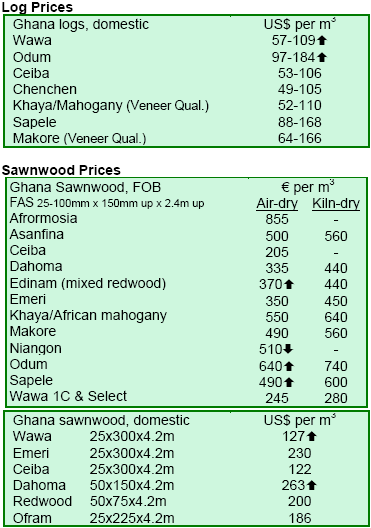
3.
MALAYSIA
Malaysia timber market takes week long break
The timber market in Malaysia took a week long break in late October as both Hindus and Muslims celebrated their
respective religious holidays. Almost all business activities ceased for the whole week.
Late monsoon prompts withholding of quotations
Heavy rainfall and flooding due to the current monsoon season have prompted a number of timber merchants to
withhold price quotation until the festive holidays were over. There were only slight price increases for plywood
products. Prices of Malaysian timber products are expected to rise from November 2006 onwards.
Faltering US economy raises concern in Malaysia
Reports that the US economy only grew 1.6% in the third quarter and that spending on new housing contracted by
17.4%, the biggest annual decline in more than 15 years, continued to be a major source of concern for Malaysian furniture manufacturers. The USA is the largest market for
these manufacturers. The industry has yet to draft a contingency plan to overcome any shortfall in the US
market.
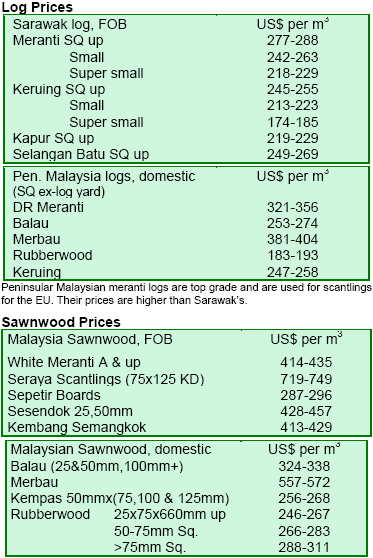
4.
INDONESIA
Timber prices unchanged during festive holidays
There were no changes in Indonesian timber prices due to religious celebrations. The Hindu (Deepavali) and Muslim
(Hari Raya) festive holidays lasted from 21 to 29 October. Most businesses were set to resume in the first week of
November.
Almost all business activities came to a standstill in the largest Islamic country in the world as hundreds of
thousands of Indonesians travelled to their hometowns to celebrate the end of the fasting month. Prices of all
Indonesian timber products were consequently unchanged.
Late monsoon rains prolong haze over Southeast Asia
The late arrival of the Monsoon rains was prolonging the smog clouds covering many parts of Indonesia and
neighbouring countries. Five regional Indonesian airports in Borneo and Sumatra islands were closed last week due
to haze from hundreds of illegal land-clearing fires. The region's monsoon rains generally start in early October.
The Indonesian Minister of Environment, Rachmat
Witoelar, said there were indications that the El Niño was responsible and, if that were the case, the wet season
might be delayed by a month.
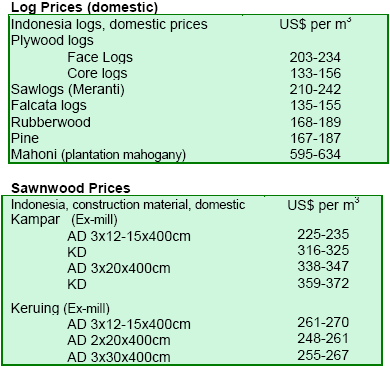
5.
MYANMAR
China set to become leading market for teak
The sealed teak tender was scheduled on 27 October and the main tender on 30 October. Teak logs were buying and
selling well in late October. Vietnam and China markets were reported as active. China was expected to become the
most important market for teak in the coming years. The
Indian market was reported to be moderately active but it might be not as active in future, according to some
experienced buyers. However, analysts agreed that the importance of India should not be discounted. Teak is one
of India's indigenous species and has been the preferred timber for many generations. It is, therefore, assumed that
the popularity of teak will still be maintained there.
Moreover, India has its own sources of high quality home grown teak, and many believe that India imports teak only
to lessen the pressure on its forests.
Gurjan outperforms pyinkadoe in log sales
The pyinkadoe log market was reported as very weak. Sales were sporadic and in small quantities. In contrast,
almost all the gurjan (keruing) logs from the 2005 extraction have arrived in Yangon and have been sold.
Fresh logs felled in 2006 will be available starting from November. If current prices hold, the gurjan market is
expected to remain stable through April 2007.
Myanmar Furniture Fair nets strong orders and sales
The Myanmar Furniture Fair was held on 21-25 October, featuring 47 companies exhibiting wood, rattan and
bamboo products in 162 booths. Wood working machines were also on display. Unconfirmed reports indicated that
the total value of orders received during the fair ranged from $1.75 million to $3.5 million.
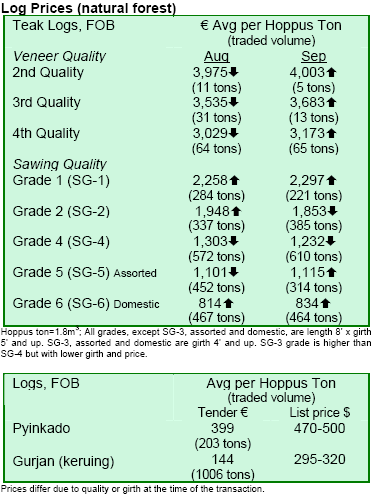
6. PAPUA
NEW GUINEA
PNG log exports lost significant ground in August
Log exports from PNG fell to 173,587 m3 in August 2006, down 20% from July and 29% from August 2005.
However, accumulated log exports in the year to August were 11% ahead of the pace last year (see chart).
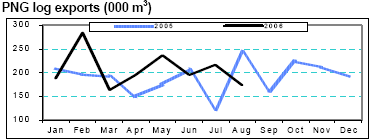
Total log exports (excluding plantation) amounted to 2.44
million m3 in the year to August 2006. Saw/veneer grades accounted for 85% of the total. Main log export species
were taun, malas, bintangor and terminalia. China took 80% of all log exports, followed by Japan (8.5%),
Vietnam (4.8%) and Korea (3.5%). Of the saw/veneer log grades, China imported 88%, Japan 6%, Korea 2.4% and
Vietnam 0.9%. For plantation species, kamarere remained the main export species primarily to the markets of
Vietnam, Japan, China and Korea.
Forest Authority holds regional seminar on FLEG
The PNG Forest Authority (PNGFA) recently held a South Pacific Regional Seminar on Forest Law Enforcement and
Governance (FLEG) attended by several stakeholders and international bodies, including ITTO, World Bank,
SGS, CIFOR, Australia's Department of Forestry and the EU. The seminar was to serve as an input to a study on forest
law enforcement in PNG being funded by ITTO. The following are some highlights of the discussions.
Forest sector is PNG's second largest export earner
Dike Kari, PNGFA Acting Managing Director, explained the contribution of the forest sector to PNG economy. The
sector contributed 3-5% to the country's GDP. Over the last six years, annual
foreign exchange earnings from forestry had averaged $156 million and reached $173
million in 2005. This made forestry second only to the mining and petroleum sector as an export earner. The
sector accounted for around 5% of the exports and, for over a decade, it had contributed an average of 30% to
PNG's development expenditure. PNGFA estimated that the sector directly employed 9,000 people (4% of formal
national employment), mainly in the rural areas. In addition, the sector was a major contributor to rural
infrastructure development, including roads, airfields, air services, health clinics, services and schools.
Timber royalties were paid to landowners at a standard rate of 10 kina ($3.3) per m3 of log harvest whilst
premiums were paid on an agreed percentage of the log export value.
Landowners seek more voice and participation
Gonene Kurokuro, landowners¡¯ representative, acknowledged the contribution of the forest sector to the
country's economy but said that landowners had largely been mere spectators in the
decision-making process, management and use of their resources. He urged the
government to give landowners more voice in decisions and include their representatives in the board for the
screening and allocation of forest concessions. Mr. Kurokuro said that illegal activities in PNG occurred due
mainly to:
• Politic influence: some logging companies having direct access to politicians sometimes
by-passed certain allocation processes. This was due to substantial pressure from politicians on the PNGFA management.
• Weak enforcement and monitoring: Non-existent field officers in project areas due to lack of logistical and
financial support, resulting in logging companies furthering its own boundary permits into new areas.
• Laxed enforcement: rules and regulations were not strictly enforced resulting in non-compliance to
penalties by logging companies.
He requested the government to assist landowners in taking up forest concessions. The assistance would be in
the form of training and relaxed loan policy to allow for landowners to participate actively in the forest industry.
While eco-forestry had a place in PNG, the majority of the key local NGOs agreed that commercial timber harvesting
was important for the PNG economy and should continue
albeit on a sustainable basis.
Some environmental NGOs (ENGOs) withdrew participating in the seminar following
PNGFA's request
for them not to raise the revised National Forest Plan in their presentations, a plan which had been legally
challenged by NGOs before the court. PNGFA explained that taking the issue up would constitute contempt of
court.
SGS refutes claims of rampant illegal logging in PNG
Bruce Telfer (New Zealand), general manager of Soci¨¦t¨¦ Generale de Surveillance (SGS) PNG office, explained the
role of SGS in ensuring that all logs exported from PNG were legal. In 1991, the PNG Government developed the
new Forestry Act and a new forestry policy to address the
shortcomings of the previous forest policy developed in 1979. The PNG Forest Authority (PNGFA) was
subsequently created with the mandate to implement the Forestry Act 1991 and the Forest Policy 1991. The
government then contracted the monitoring of log exports to an independent third party in May 1994. SGS was
engaged to provide independent, arms length monitoring of all log exports from PNG, to ensure that logs exported
were sold at the prevailing market prices and that export shipments were correctly declared with respect to log
volume and species.
Mr. Telfer said that PNGFA and SGS had developed and implemented a very robust monitoring system for all
round logs exported from PNG, which involved the following:
• provision of log tags to be affixed to the end of each log by producers at the time of scaling at the log landing as
prescribed by the PNGFA;
• pre-shipment log inspection to check species identification and log scaling; and
• monitoring of ship loading to verify the species and volumes actually loaded.
No logs could be legally exported from PNG until all the prescribed procedures involving 22 steps had been
followed. According to Mr. Telfer, in the last 12 years, SGS had not uncovered large-scale log smuggling in the
log export trade in PNG. SGS provided monthly statistical reports to the relevant PNG government agencies on all
log shipments. These statistical reports as well as records available at SGS office in Port Moresby could be verified
independently, and indicated that since 1995, SGS had inspected more than 25 million m3 of logs from 80 logging
camps with an FOB value of more than 4.45 billion kina ($1.5 billion).
Mr. Telfer added that the efficiency of the log monitoring system was confirmed by statistics from
ITTO's Annual
Review that indicated that the log trade difference between reports from PNG and China, the largest importer of PNG
round logs, was only 2% in 2005. The small difference could be accounted for by insurance and freight charges.
In relation to allegations that logs were being exported illegally from remote PNG islands, Mr. Telfer indicated
that this was highly unlikely. He explained that it was logistically impossible to secretly fully load a ship either
in the night or during the day without leaving some kind of evidence behind. In addition, it was logistically
impossible to load a ship full of logs overnight. SGS had officers stationed on concessions where commercial
harvesting of logs for export occurred. He said there were about 42 active log export sites in PNG. SGS was able to
verify expeditiously any reports of illegal activities relating to the export of logs. Such checks had been carried out in the past and had not shown illegal activities
by log exporters.
According to Mr. Telfer, the unique numbering system of SGS tags affixed to exported logs enabled the origins of
individual logs to be traced back to the concession from where they were harvested. UK and other overseas buyers
who doubted the legality of the source of PNG logs were therefore able to verify this information from
SGS.
PNG urged to showcase its log monitoring system
Dr. Kwame Asumadu (Australia) from Asumadu Pty Ltd said the SGS monitoring system in PNG provided a
verifiable proof that allegations of rampant log smuggling were highly questionable. He and others urged the
government to publicize the existence of the system in export markets as it was unknown overseas. Attendees
said PNG should use it to counter allegations of illegal log
trade by environmental NGOs, particularly in Europe and Australia. One of the consequences of the allegations led
the UK Timber Trade Federation to warn its members to avoid timber products made of tropical logs from PNG
(see TTM 11:12).
Dr. Asumadu noted that only other few tropical timber producer countries had implemented log-tracking systems,
including Ghana, Ecuador, DR Congo, Cameroon, Guyana, Brazil and Peninsular Malaysia. The PNG and
Cameroon systems appeared to be the only ones implemented and managed by an independently appointed
body, at arms length from the government or the forest
agency.
A World Bank's report claiming that up to 70% of logs harvested in PNG were illegal was challenged by the
PNGFA and the industry. The representative of the World Bank informed that it had contacted the authors of the
report to support their sources and that the results of the inquiry would be conveyed to
PNG.
Seminar calls for effective implementation of forest law
Some of the seminar's conclusions were:
• PNG has a framework in place which can assist in achieving sustainable forest management, as well as
enhanced forest law enforcement and governance.
• The government should involve landowners in decision making processes.
• PNG should aggressively publicize the SGS log monitoring system in main export markets.
• Although effective in minimising log smuggling, the SGS monitoring system cannot provide a guarantee that
all forestry activities in PNG are legal.
• Like many tropical timber producing countries, the major challenge facing PNG is effective implementation
of its forest law and policies, as well as monitoring to ensure continuous improvement.
• The fact that PNG can further improve its performance in sustainable forest management cannot be used to
justify allegations that all commercial harvesting activities in the country are illegal. There has been a
tendency to confuse ¡ˇăillegality¡ˇŔ with ¡ˇăeffective implementation¡ˇŔ of the Forest Act and related policies and guidelines in the commercial timber harvesting
debate in PNG.
• There is a need for a definition of illegal harvesting activities in the context of
PNG's forestry law and
policy. At present, there is no agreed national definition of illegal harvesting activities in PNG. This has been
used by some ENGOs to indicate that commercial timber harvesting activities are not legal unless the
operations have met all laws and regulations and international treaties including labour rights, indigenous
people's rights and the payment of all taxes and fees. This is a much broader definition and encompasses
areas of responsibility, which are beyond the mandate of
the PNGFA. Based on this definition, commercial timber harvesting activities in almost all timber
producing countries in the world, both developed and developing, would be illegal in one way or the other.
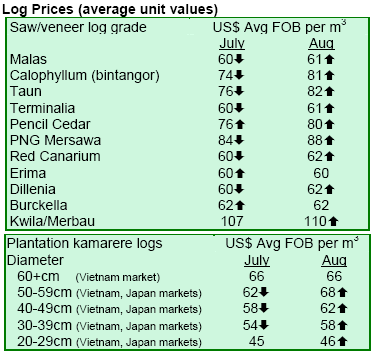
7.
BRAZIL
Tropical timber products buck falling trend in exports
Exports of solid wood products rose 11.6% to $355 million in September, compared with the same month last
year. Exports of pine sawnwood exports fell 24.6% to $19.8 million (down 28% to 97,700 m³) while those of tropical
sawnwood rebounded 18.3% to $54.3 million in spite of the export volume surging only 2.6% to 138,900 m³. In
contrast, exports of plywood declined in September. Exports of pine plywood dropped 26% to $34.2 million
(down 23% to 134,000 m³) while those of tropical plywood fell less sharply in value (4%) to $20.3 million
(down 26% to 41,800 m³) helped by comparatively higher prices. Furniture exports continued the downward trend,
sinking 3.7% to $69 million.
Plywood exports slip amid slowdown in the USA
The decline in international demand for plywood (particularly in the USA) and the unfavourable exchange rate had knocked
down Brazilian plywood exports. As a result, the sector was registering declining international sales for the second
consecutive year. The Brazilian Association of the Mechanically Processed Wood Industry (ABIMCI) forecast
that the sector would close with a 15-20% decrease in external revenues in 2006 from $785.7 million in 2005. The sector had started to feel the consequences of the deceleration
of the US housing market, the main user of Brazilian
plywood. In the first three quarters of 2006, exports of the reconstituted wood panel sector fell 13.6% to $505.1 million
compared with 2005, according to the Secretary of Foreign Trade (SECEX).
Companies were downsizing production and firing staff. For instance, in the plywood production cluster of Palmas in
Southern Paran¨˘, the largest in the country, the industry had laid off 3,000 workers in the last three months, closed at least
four plants or reduced production to around 10% of their capacity.
Tropical plywood prices soar as supplies tighten
The reduction of the demand for plywood in the USA has also led to a fall in prices in international markets, particularly
those for softwood plywood. In contrast, tropical plywood has benefited from price hikes and reduced volume of
Chinese and Indonesian plywood in the international market,
pressed by allegations of illegal log use. Prices of tropical plywood were around $400 per m³ recently, compared with
$310 per m³ two months ago. The USA and Europe accounted for a combined 85% of the Brazilian plywood
exports. The remaining 15% was shared among Middle East, the Caribbean and Asian markets.
Prices for elliotis plywood retreat to previous levels
After a brief hike in early September, prices for Brazilian elliotis pine plywood fell back to late
August's levels in
Europe, reported Euwid. Brazilian producers had raised prices by as much as US$15 per m3 to offset 30-40% hikes
in adhesive resin costs. The fall in elliotis plywood prices
had extended the production cutbacks in the Brazilian plywood industry. The mills average capacity utilization
had hence fallen to less than 50%.
Demand for elliotis pine plywood remained subdued in the EU and US markets. The situation in the USA continued
to be affected by the slumping housing market and overcapacities in US softwood plywood, particularly
southern yellow pine plywood. In Europe, demand for elliotis pine plywood was still falling short of the
expectations in most markets. First purchases for the 2007 duty free quota were made in early September while the
expected revival in demand for October failed to materialize. Nonetheless, analysts assumed that once price
levels stabilized, importers would resume placing orders against the quota in November at the latest.
SEBRAE gives helping hand to Amazon wood chain
The Brazilian Service of Support to the Micro and Small Businesses (SEBRAE) has developed a project
(ProAPLWood and Furniture) to strengthen and integrate the Amazon productive wood chain and to create products that
can be associated with the region. The project will support the production of wood furniture parts and components
from the Northern region.
SEBRAE intends to strengthen local governance in the sixteen existing Wood and Furniture APL of the region so
that leadership can find solutions for difficulties, especially in relation to the origin of raw materials. One of the challenges will be the acquisition of knowledge and
inducing the furniture sector to utilize only wood from managed and certified forests. In the state of
Amap¨˘, for
example, the sector is practically paralyzed due to the interdiction of more than fifty lumber companies by
IBAMA in recent months. The production of exclusive furniture associated with the Amazon region will be one of
the major aspects of the new SEBRAE project. Consultants and designers will be contracted to support the
construction of the Amazonian identity in the furniture sector.
One-fifth of Par¨˘ could be under SFM
One-fifth of Par¨˘ 1.25 million km2 could be under sustainable forest management (SFM), according to a
study by the Institute of the Man and the Environment of the Amazon (Imazon).
Para's government goal is to
allocate 450,000 km² of the forest within an ecologic-economic zone (ZEE).
Par¨˘ is the main source of forest products of the so-called Legal Amazon, an area encompassing almost half of the
area of the country. Log production reached 11.2 million m³ in 2004, with most of the production (around 90%) resulting
from excessive forest harvesting, lacking management plans
and sometimes in public forestlands, according to Imazon. The eastern part of the State accounts for 48% of the
lumber production. Imazon said there were signs of weaknesses in raw material supply as a result of nonsustainable
logging. The southern corner of Par¨˘ has gone through a similar process over the last two decades.
The study was presented to the state government as an instrument for the implementation of public policies that
could prevent wood depletion in the State. Imazon added that current trends show lumber companies operating in
the southern and eastern parts of the State, moving to the central and northern areas along the Amazon River
looking for valuable commercial species.
Protected areas in Amazon expand twofold
Protected area in the Amazon rain forest has nearly doubled in the past three years, according to Tasso
Azevedo, Director of Brazil's Forest Service. More than 70 million ha of the forests would legally be either off-limits
to development or reserved only for sustainable use by the end of the year. Only about 30 million ha had been
declared protected before 2003, when President Lula da
Silva took office pledging to reduce deforestation, Azevedo said. The federal government had since declared
the protection of almost 20 million ha, while state authorities had protected an additional 8 million ha.
Federal and state officials planned to protect an additional 15 million ha by the end of the year. Some of the land
would be near the BR-319 dirt road connecting Manaus (Amazonas state) to Rondonia state, which, after being
paved, was expected to attract developers to the area.
Many environmental institutions, including Greenpeace, praised the
government's results in the Amazon. Azevedo
said Brazil had spent about $93 million fighting deforestation, including hiring agents for Brazil's
environmental protection agency.
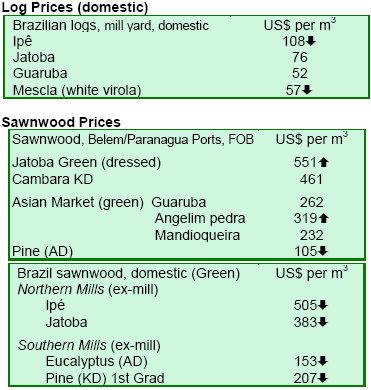
8. PERU
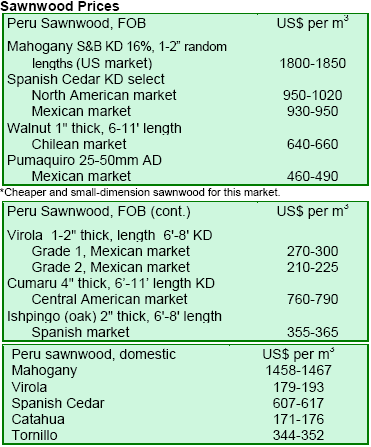
9. BOLIVIA
Processors in business partnerships with communities
The first business meeting between forest indigenous and peasant communities with Bolivian wood processing
companies was held on 20 October 2006 in Santa Cruz, Bolivia. The meeting was organized by the Forestry
Chamber of Bolivia (CFB), the Chamber of Commerce and Industry of Santa Cruz (CAINCO), the National
Indigenous Forest Association (AFIN) and the National Social Groups Association (ASL) with the support of the
Amazon Center for Sustainable Forestry (CADEFOR) and WWF-Bolivia. The main objective of the meeting was to
strengthen commercial relationships between indigenous communities and private companies and speed up the
business dynamics among them. The meeting was attended by 14 social groups and indigenous
communities and 35 companies, which held 128 business meetings and agreed on some $6.5 million in business intentions. Two
wood processing companies signed long-term wood supplying contracts with two indigenous communities.
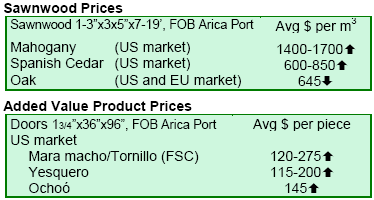
10. Guatemala
Guatemala continues expansion of plantation program
About 7,540 ha of broad leaved species were planted in Guatemala in the year up to September. The plantations
were carried out under the Forest Incentives Programme (PINFOR), involving species such as Tectona
grandis, Tabebuia donnell-smithii and Gmelina arborea.
FTA boosts timber exports to the USA
Exports to the US market have risen since the Free Trade Agreement (FTA) between Guatemala and the USA came
into effect in July 2006, a trend which is expected to continue. Guatemala's exports of forest products to the
USA were only $8.3 million in the first half of 2006 but amounted to $11.6 million just in the third quarter of 2006.
Exports of teak sawnwood were only $15,650 in March but had almost doubled to $28,453 in September 2006.

11.
Guyana
Forest sector targeted to boost
Guyana's development
Guyana's new National Competitiveness Strategy (NCS), the outcome of a sort of social partnership between the
government, labour and private sectors to lift Guyana's global competitiveness with the ultimate goal of delivering
¡ˇăgreater economic growth¡ˇŔ, has identified the forestry sector as one of the sectors being targeted to catalyze
Guyana's development. The other sectors identified included non-traditional agriculture, fisheries,
manufacturing, tourism and information and communication technology.
At present sugar is the country's single largest export earner, grossing an estimated $160 million in 2005,
accounting for 30% of merchandise exports and 18% of GDP. The forestry sector contributes 6% of the exports,
around 4% of GDP and about 20,000 jobs.

|